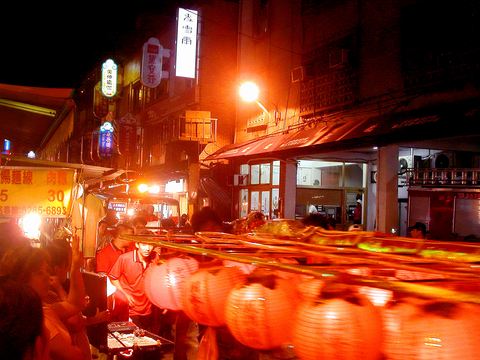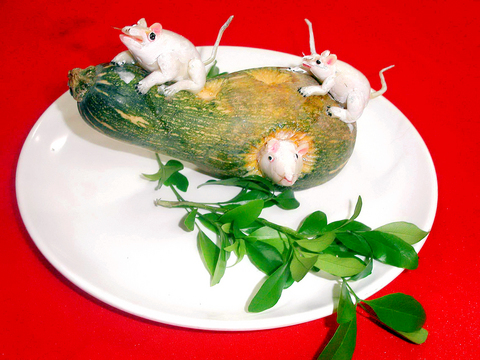People who attend the Mid-Summer Ghost Festival at Lujhou (
The reason for it is very simple, said Yang Lien-fu (
"There are so many good religious traditions that are on the verge of extinction," he said. "As the second generation of the temple's management, I feel obliged to carry forward old traditions and keep them alive as long as possible."

PHOTO COURTESY YONGLIAN TEMPLE
The temple took over the city's public sacrificial rites for the Mid-Summer Ghost Festival about four years ago. It now has one of the nation's most elaborate Ghost Festival religious ceremonies, after that of Keelung City.
Built in 1873, Yonglian Temple is the center for Buddhist worship in Lujhou. It has gone through various renovations and expansion projects over the years, with the latest renovation work being completed in 1997.
Festival roots

PHOTO COURTESY YONGLIAN TEMPLE
The festival, which makes offerings on the 15th day of the seventh lunar month, is a custom dating back thousands of years.
According to Buddhist beliefs, the festival originates from a story about Moginlin, a disciple of the Buddha Sakyamuni. He went to hell to rescue his mother, who was being punished for selfishness and failing to do good deeds when she was alive.
The Buddha told him that if he wished to relieve his mother from her suffering, he should offer five fruits and 100 delicacies to all ghosts on the 15th day of the seventh lunar month.
Taoists, meanwhile, believe that the festival is held to mark the birthday of the Guardian of Hell, who governs all matters in the underworld. He decreed an amnesty so all lost souls in hell could be released to return to the mortal world on the first day of the seventh lunar month. They enjoy incense, candles and food offered to them for one month so that they might be converted to "the Way."
In current practice, the Mid-Summer Ghost Festival begins on the first day of the seventh lunar month and is marked by the opening of the gates of the underworld. All the wandering, hungry and lonely ghosts in hell then return to the world of the living for one month.
On the 14th day, a parade is held and lanterns are released on waterways to light the way for abandoned souls and lead them to dry land.
A ceremonial dance is performed to welcome deity Chung Kwei (
Paste offerings
Nowadays, paste sacrificial figures are distributed to festival goers at the end of the day for home decoration. They are not edible -- although about 20 or 30 years ago they were. In earlier times, paste figures were also offered at house-warming parties or weddings.
According to Hung Shih-hsien (
For the modern version of these figures, food preservatives are added to the dough, which is made of flour, rice powder and water. After the figures are dried, they are painted and then varnished with a plastic coating to prevent them from cracking.
Finished figures made out of the dough can last for as long as a year, said Lee Chun-hsiung (
Paste figures mounted on perishable vegetables such as potatoes, pumpkins or bitter squash, though, last for between three and 10 days. Some figures, such as birds made out of papier-machet, can last for two to three years.
In addition to the paste figures and papier-machet, Lee can also make fish ice sculptures and carve turnip cranes for the event.
It takes Lee about a month to finish around 100 pieces of art for the festival. A blessing by monks then symbolically multiplies the 100 items so that they can feed the countless ghosts who will attend the festival.
Lee's catering business is deteriorating rapidly, however, and paste-sacrifice art is declining in popularity as Lujhou becomes urbanized. Lee said he is planning to venture into a more lucrative business, and will open eateries in Lujhou and Sanchong (
Dying art
During its peak, Lee said his catering business had more than 20 engagements a month, but the number has now dwindled to about 10.
Lee started learning the skills of the business from his father, a professional caterer for weddings, funerals, birthday parties and religious events, at the age of 25. He is 39 now.
His father's exquisite skills in making paste figures earned him an award of excellence at the 1996 Taipei Chinese Culinary Exhibition.
Now, the Lees number among the nation's few masters specializing in the art. The younger Lee says that he knows of one other person who has mastered the art -- a 60-year-old living in Sanchong.
Pig sacrifices
About 10km away from the Yonglian Temple, a different type of religious tradition is taking place. The Ghost Festival had attracted about a dozen pig farmers carrying truckloads of sacrificial pigs to the Tachong Temple in Pali (
The 210-year-old Tachong Temple has just been designated as having historically significant architecture, and temple managers hope to begin a renovation project by the end of next month to give the building a face-lift.
Chou Chin-tiao (周金條) won this year's pig-raising contest with an animal that weighed 890kg. The first runner-up came in far behind, at under 500kg, with the second runner-up weighing about 400kg.
This was the fifth time Chou won the contest. The secret of growing such a big pig, Chou said, lies in the fodder. The feed he uses contains grain shells, rice porridge, canned fish, pig oil, milk powder and raw oysters.
The animal is fed twice a day, with 14kg of fodder each meal, and is given water every three hours. The cost for the fodder alone is about NT$30,000 a month.
During the summer, he has seven fans blowing on the animal to keep it cool and comfortable.
During his some 30 years of pig farming, Chou said that only three pigs died under his care. Although he spends more time and effort taking care of the animals than his wife and four children, Chou said that it pays off when he wins the highest honor.
"I don't raise the pigs for the gold plate or certificate of merit," he said. "I do it to fulfill a promise I made to the Buddha when I was poor that I would offer big sacrifices if I could have food to eat and clothes to wear."

ANOTHER EMERGES: The CWA yesterday said this year’s fourth storm of the typhoon season had formed in the South China Sea, but was not expected to affect Taiwan Tropical Storm Gaemi has intensified slightly as it heads toward Taiwan, where it is expected to affect the country in the coming days, the Central Weather Administration (CWA) said yesterday. As of 8am yesterday, the 120km-radius storm was 800km southeast of Oluanpi (鵝鑾鼻), Taiwan’s southernmost tip, moving at 9kph northwest, the agency said. A sea warning for Gaemi could be issued tonight at the earliest, it said, adding that the storm is projected to be closest to Taiwan on Wednesday or Thursday. Gaemi’s potential effect on Taiwan remains unclear, as that would depend on its direction, radius and intensity, forecasters said. Former Weather Forecast

As COVID-19 cases in Japan have been increasing for 10 consecutive weeks, people should get vaccinated before visiting the nation, the Centers for Disease Control (CDC) said. The centers reported 773 hospitalizations and 124 deaths related to COVID-19 in Taiwan last week. CDC Epidemic Intelligence Center Director Guo Hung-wei (郭宏偉) on Tuesday said the number of weekly COVID-19 cases reported in Japan has been increasing since mid-May and surpassed 55,000 cases from July 8 to July 14. The average number of COVID-19 patients at Japan’s healthcare facilities that week was also 1.39 times that of the week before and KP.3 is the dominant

The Chinese Communist Party’s (CCP) working group for Taiwan-related policies is likely to be upgraded to a committee-level body, a report commissioned by the Mainland Affairs Council (MAC) said. As Chinese President Xi Jinping (習近平) is increasingly likely to upgrade the CCP’s Central Leading Group for Taiwan Affairs, Taiwanese authorities should prepare by researching Xi and the CCP, the report said. At the third plenary session of the 20th Central Committee of the CCP, which ended on Thursday last week, the party set a target of 2029 for the completion of some tasks, meaning that Xi is likely preparing to

US-CHINA TRADE DISPUTE: Despite Beijing’s offer of preferential treatment, the lure of China has dimmed as Taiwanese and international investors move out Japan and the US have become the favored destinations for Taiwanese graduates as China’s attraction has waned over the years, the Ministry of Labor said. According to the ministry’s latest income and employment advisory published this month, 3,215 Taiwanese university graduates from the class of 2020 went to Japan, surpassing for the first time the 2,881 graduates who went to China. A total of 2,300 graduates from the class of 2021 went to the US, compared with the 2,262 who went to China, the document showed. The trend continued for the class of 2023, of whom 1,460 went to Japan, 1,334 went to